u-he
Showing all 11 results
Showing 1 - 11 out of 11
Page 0 out of 0
| Rating | Image | Product | Price |
|---|---|---|---|
|
4.84 SOUND QUALITY FEATURES VALUE FOR MONEY EASE OF USE |
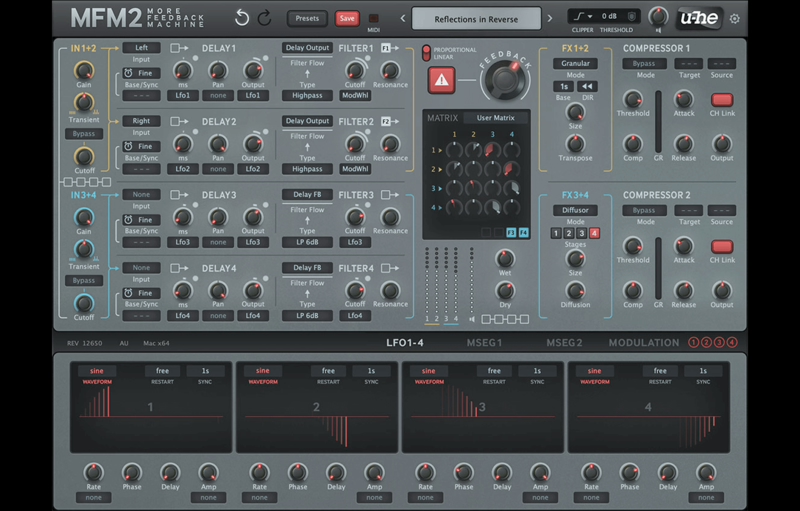 |
MFM2Version 2.5 of u-he’s monster delay plug-in More Feedback Machine is now available. The new version comes with a redesigned GUI, native support for Apple silicon, VST3 and CLAP (the new open source plug-in format), a new input section, new granular and diffusion effects… and quite a lot more. The 3D circular arrangement of elements in the previous version has made way for a more practical design, and In case anything remains unclear despite the streamlined UI, users can access the user guide and other documentation by clicking on the u-he logo. Several of the new factory presets feature the Diffusor effect, demonstrating that version 2.5 is also quite a capable reverb unit. Fans of experimental effects will also welcome the Granular feature, which includes a reverse option and host-syncable grain size. MFM2.5 can do…
2 Input Processors Input signals can be processed in pairs before being sent to the delay lines. The “Transient” controls suppress or boost spikes. The two non-resonant input filters can reduce the frequency range or even split the frequencies into two stereo bands with independent delay settings (set In 1+2 to Lowpass and In 3+4 to Highpass with the same Cutoff value). 4 Delay Lines Independent delay modes: synchronized, free, or even controlled by MIDI notes. The dark field below each knob is a modulation source selector, and the amount of modulation is controlled by the “pip” which appears at the top right of the knob. 4 Main Filters Resonant filters can be placed in various positions within the signal path. On offer here: 2x low pass, 2x high pass, band pass, band reject, allpass (phaser). The Feedback Matrix This is where you can specify how the delay lines feed into each other: The “User Matrix” option lets you freely route signals between all 4 delay lines. The large control at the top adjusts the overall amount of feedback. At the bottom of the panel are the output level controls, allowing for normal and inverted polarity. 2 Effects Pre-feedback processing. On offer here: limiter, bit crusher, phaser, frequency shifter, lowpass/highpass filter, granular pitch shifter, diffusor (reverb-ish). 2 Compressors The final polish! Peak or RMS mode compression. In PeakComp mode you can compress one pair of channels using a sidechain from the other. Creating new effects in MFM2 can be quite complex, depending on how deep you want to go! Below is a very brief introduction so you can get some idea of what awaits you as MFM2 tweaker… Features
Mac
Windows
Linux
Minimum Requirements
|
Price History: MFM2 99.00 $ |
|
4.8 SOUND QUALITY FEATURES VALUE FOR MONEY EASE OF USE |
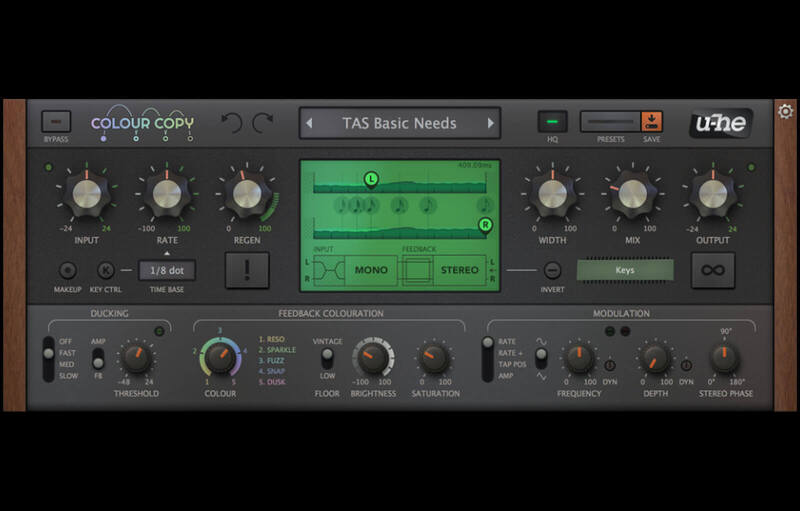 |
Colour CopyColour Copy: A Bucketful of Delay A virtual analog effect inspired by classic bucket-brigade delays (BBD) but extended with modern features. We called our new baby “Colour Copy” because it can deliver the kind of colouration people still love in classic BBD units, but with a wider variety of colours. Colour Copy started life as the little delay unit called “Lyrebird” we built into Repro-1, but the sound was too good not to be developed further and become an fx plug-in. Colour Copy in the spotlight…
In most digital delays the delay time alters the size of the buffer. If you quickly modulate or sweep the delay time on a typical digital unit, unmusical glitches propagate through the feedback as the buffer is shortened or lengthened. Like a real BBD, Colour Copy changes the internal sample rate instead (i.e. how fast the “buckets” pass on their content), and this is why Colour Copy is smooth with a capital SMOO! MAIN FEATURES Colours The differences may be subtle, but each one is rich in detail. In addition to obvious differences in frequency bandwidth, each comes with its own noise and dynamic characteristics, frequency loss over time, and several other qualities. The Saturation knob controls how prominent or subtle those characteristics should be, in case you want to dial back the colouration to better fit in the mix. Finally, a Brightness knob lets you adjust the bandwidth. Flexibility The routing options let you mix or swap the input and feedback signals independently or even invert the feedback phase for various phase cancellation effects when delay times are set very short. Additionally, unlike hardware BBD units, Colour Copy’s left and right output “taps” can be placed anywhere along the delay lines. This feature lets you move echos independently “forward in time” for e.g. ping-pong or “rushing” delays as well as various stereo chorus or flanger effects. You never knew you’d want three different ways to create a ping-pong effect! Animation Colour Copy comes with the obligatory ducking compressor, but with a unique twist: You can select whether to duck the entire delay output or just the feedback signal. This latter option leaves the very first delay unaffected, preserving the overall stereo “space” while preventing the sonic mayhem that high regeneration often causes. Performance Control We took Colour Copy a step further in this direction by adding a pair of creative features: Firstly, a freeze button that loops the contents of the delay buffer for as long as you like. Secondly, midi key control so that you can play Colour Copy like a mono synth – each octave up doubles the delay rate. System Requirements
Formats
|
Price History: Colour Copy 69.00 $ |
|
4.74 SOUND QUALITY FEATURES VALUE FOR MONEY EASE OF USE |
 |
Repro-1Repro dives into the past for analogue inspiration, meticulously modelling two famous synthesizers. Every detail of the original was captured using component-level modelling technology to create the most authentic model possible. All the subtle characteristics and quirks found in the originals are present in Repro. One product, one installer, two synths. Repro contains Repro-1 and Repro-5. Repro-1 is a fierce monosynth: hard working, raw sounding and immediately playable. The classic design is simple and intuitive but belies a deep feature set capable of a wide range of sounds. Repro-5 is the new polyphonic addition. It has a lot in common with Repro-1, a similar design and feature plus shared sonic DNA. But Repro-5 introduces new flavours, most notably is ability to play lush chords or thick unison leads, while keeping the authentic analogue sound. At first glance Repro-1 and Repro-5 are simple and intuitive, but the clean and classic designs hide deep feature sets capable of a wide range of sounds. MAIN FEATURES Repro-1:
Repro-5
Shared Features:
Mac OS X 10.9 or newer or Windows Windows 7 or newer or Linux
Repro is not a standalone product, it requires host software. Repro is compatible with nearly all DAWs. Available as Audio Units (AU), VST2, VST3, AAX (Pro Tools 10.3.7 or later) NKS, plug-ins with 32-bit and 64-bit versions. NKS supportRepro supports Native Instruments’ NKS format and is compatible with Maschine and Komplete Kontrol hardware. |
Price History: Repro-1 149.00 $ |
|
4.72 SOUND QUALITY FEATURES VALUE FOR MONEY EASE OF USE |
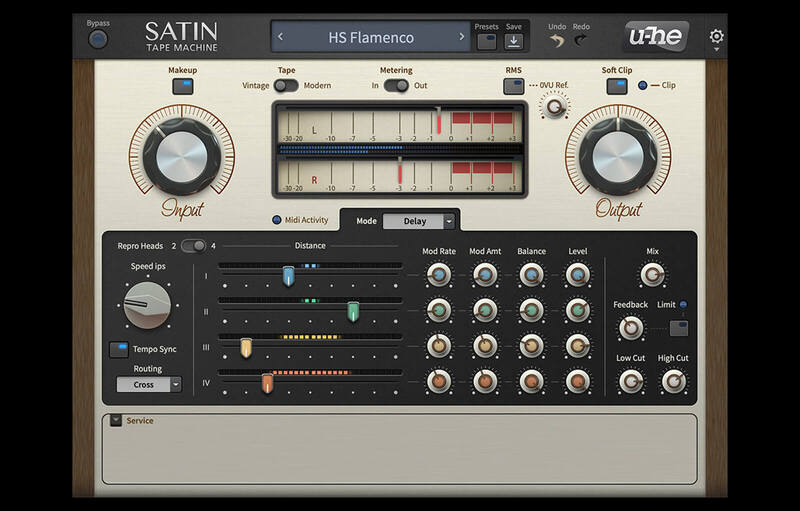 |
SatinTape Construction Kit We took a journey back to the Golden Age of magnetic tape recording. We wanted to recreate all kinds of tape machines in software, from the ground up. After many months spent on research, measurement and on developing an architecture that would be flexible enough for the job, we knew we had nailed it… But we couldn’t stop there: We added the old noise-reduction systems that were often (mis)used for timbral compression effects. Then more heads and a global feedback path, which made an uber-tape-delay and realistic ‘one-shot’ tape flanging possible. Users familiar with analogue recording gear should instantly feel at home with Satin, and digital aficionados will also learn to love the magic of tape – Satin invites you to explore and find out for yourself. Presets Satin ships with a wide variety of presets – emulations of classic professional tape machines, cheap ‘n nasty tape machines, tape delays, tape flanging/chorus… and a whole lot more! Gains The two large knobs adjust input and output levels – probably the most important controls in Satin! Metering Precise visual signal level monitoring is ensured through a combination VU & peak meter, with switchable RMS mode and variable reference level. Delay 2 or 4-tap delay with variable routing, cyclic modulation, feedback filtering and limiter. Easily create beautiful organic space or precisely synchronized, complex patterns. Flanger Unlike regular LFO-controlled digital flangers, this is the real deal. True tape flanging that legendary ‘swoosh’! Doing this on a pair of real tape machines takes skill and practice – with Satin, you simply activate the Trigger. Grouping In Studio mode, you can assign each instance of Satin to one of the eight groups. Each group will behave as a multitrack tape, ‘remote-controlled’ from any instance in that group. Companders A choice of encoder and decoder circuits brings back the era of noise-reduction systems that were (mis)used for all kinds of dynamic and spectral effects, including the legendary ‘A-type vocal trick’. TapeControls Satin’s speed control is continuously variable from 7.5 up to 30ips – it even re-adjusts the entire machine model as you tweak. Pre-emphasis allows for precise control over transients, tone and fidelity. Service Panel Satin lets you get seriously technical whenever you want: adjust numerous attributes of the tape, the heads and the surrounding circuitry. A handy analyzer makes alignments such as biasing easy and precise. MAIN FEATURES
Mac
Windows
Minimum Requirements
Plugin Formats:
|
Price History: Satin 129.00 $ |
|
4.72 SOUND QUALITY FEATURES VALUE FOR MONEY EASE OF USE |
 |
DivaThe Spirit Of Analogue DIVA – Dinosaur Impersonating Virtual Analogue Synthesizer The oscillators, filters and envelopes closely model components found in some of the great monophonic and polyphonic synthesizers of yesteryear. Modules can be mixed and matched so you can build hybrids, but what sets DIVA apart is the sheer authenticity of the analogue sound. This comes at the cost of quite a high CPU-hit, but we think it was worth it. Diva is the first native software synth that applies methods from industrial circuit simulators (e.g. PSpice) in realtime. The behaviour of zero-delay-feedback filters when pushed to the limit clearly demonstrates the advantages of this groundbreaking approach. Check out more than 1200 presets. If your computer can handle it, try them in “Divine” mode. MAIN FEATURES
Filters Each filter type closely models a classic analogue hardware filter (or two): You can already choose between Ladder, Cascade, Multi-Mode, Bite… and more are planned! Envelopes The characteristics of amp and filter envelopes within the same synthesizer often differ.This important detail has also been carefully modeled. Mix & Match The rack also offers highpass filter models (pre or post main filter) or feedback from output to input. Effects
The two effects are arranged in series – you can even use two plate reverbs, one after the other. Modifiers There are also several modulation options here that aren’t available in all the main panels (e.g. filter resonance, feedback). Trimmers As well as detuning individual voices, a voice-specific offset is applied to cutoff, envelope times, pulse width and glide. Scope Patches Mac
Windows
Note: Diva is not a standalone product, it requires host software. Diva is compatible with nearly all DAWs. |
Price History: Diva 179.00 $ |
|
4.66 SOUND QUALITY FEATURES VALUE FOR MONEY EASE OF USE |
 |
TwangströmShake, Rattle, and Roll A flexible spring reverb box-of-tricks. If you’re familiar with Bazille, you might already have come across its built-in spring unit. We took that one, then modeled two more reverb tanks, paired it with drive section, filter stage, envelope, and mod matrix. It emulates a hand-picked selection of the most popular units you will find in classic guitar and instrument amplifiers, recreating the odd character of real springs. MAIN FEATURES
As a faithful emulation of a mechanical device, Twangström needs to be handled well. Many of the technical parameters are user-adjustable in real time, and these can be controlled via MIDI or using the internal LFO and envelope generator. With its multimode resonant filter, Twangström is a unique and powerful tool which can deliver highly unusual, evolving textures… especially when the signal is tossed around using the modulation matrix! The Reverb Tank – What’s going on?! Often referred to as a tank, spring-reverberation devices typically incorporate several metal springs suspended in a metal case. The springs are excited using electromagnetic transducers. The principle is similar to a loudspeaker, except with a spring instead of the membrane. Sound waves travel across the spring to the opposite end, where another transducer converts the mechanical energy back into an electronic signal. A lot of the energy is reflected at both ends, but mechanical damping inherent in the system means that the the sound fades away naturally. Several springs often share a transducer pair. In such cases, the transducer houses each spring’s cylindrical end-stop magnets, distributed evenly within the air gap (and enclosed by the laminated core, a stack of thin magnetic iron plates). Sharing a transducer pair minimizes mechanical and electric complexity, but the signals can only be treated as a whole. Tanks that can be operated in stereo require multiple transducers, and are therefore quite rare Of course you have them in Twangström! Some stereo systems had two complete tanks. A transmission spring follows a principle physicists call the spring-mass system, and you might recall classroom experiments in which a weight was attached to a hanging spring, making it oscillate at a certain frequency. Apart from the external mass, the physical properties of the spring (material, length, wire gauge, number & diameter of coils) have a great effect on the vibration and transmission of sound. The longer the spring, the lower the frequency at which it oscillates. Longer springs also decay more slowly than short ones, as more windings result in more kinetic energy potentially stored. Typically, reverb tanks with multiple springs are chosen for unequal delay times. Ratios based on prime numbers help in achieving dense reverb by strictly avoiding repetitive echo pattens. In a reverberation tank, the rigid suspension mounts at both ends act as a constant mass, thus damping the spring’s energy. But upon vibration, some of the energy is transferred to the other parts. In a multiple-spring arrangement, all springs share a common mounting plate, so vibration becomes an interactive process. As a result, springs interchange their wave fronts and the sound becomes more washy with each reflection. If there were no mechanical coupling involved, a minimum (static) density could be achieved by choosing suitable delay times, but there would be no buildup of echoic complexity. In real tanks a certain degree of coupling is always present, so we made it switchable in Twangström. In certain setups the echo-density buildup has another cause: the division of the spring into shorter segments. For instance, at first glance the popular Accutronics Type 4 tank appears to be two springs, but is actually four: Each sub-system comprises two springs with a small joint in between. What happens there is pretty much the same as at the suspension end of normal systems: Waves are partially reflected while most of the wavefront is passed on to the next spring. These joints seldom divide the two springs perfectly, and this fact helps spread the echos around, making the reverb tail more diffuse. Shakeable Springs Hitting your computer won’t make Twangström shatter, so we added a twang control. This is used to shake the springs, either manually or through modulation and automation. You might think this is a gimmick for which you have no further use (apart from waking up the neighbours), but if you modulate it slightly, everything comes to life! Tank Controls Twangström’s reverb is based on physical modelling. As opposed to plug-ins based on impulse responses (IR), our approach mimics the physics of mechanical reverberation. By simulating the wavefront travelling through a medium, we can include all the aspects of excitation, reflection, dispersion, interference, and other audio properties. Twangström does not mimic the sonic result, but simulates the physical device. This means that all dimensions of the device are controllable in realtime, on a per-sample-basis – which all boils down to quite some power at your fingertips! Envelope The envelope in Twangström features 4 different modes and can pick up the signal from either input, output or external sidechain. You can select between Envelope Follower, Attack and Decay, Attack and Release, or Cyclic modes. The last one is similar to a 2-stage LFO. Shown controls will adapt to the selected mode, with Threshold not appearing while in Envelope Follower mode. Modulation Matrix The modulation matrix has three general purpose modulation slots, and yes, you can select shake as one of many targets to modulate the Twang control! Low Frequency Oscillator The LFO features different time bases, including a non-synchronized one measured in seconds. Synchronized options include both dotted times and triplets. There are 8 different waveforms to choose from, with 2 of them being stepped or glide random shapes. System Requirements
Mac
Windows
Formats
|
Price History: Twangström 69.00 $ |
|
4.64 SOUND QUALITY FEATURES VALUE FOR MONEY EASE OF USE |
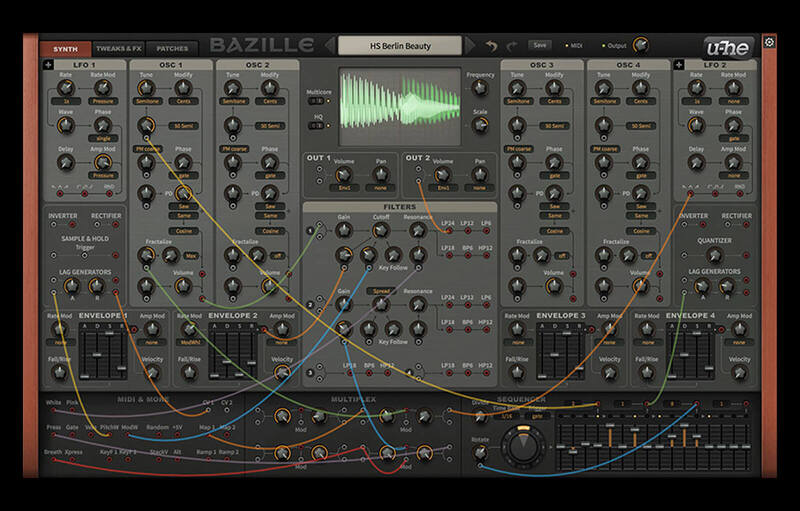 |
BazilleBazille – Digital Modular Synthesis Bazille is a large modular system combining digital oscillators with analogue-style filters and modelled effects, with a flexibility that only modular patching can provide. After ACE, the second spawn of our ongoing ‘Berlin Modular’ project, this one is a very different, much larger beast… Ultraflexible modules – Bazille is highly unusual for a modular synth. Although the filters are traditional analogue models, the oscillators are unashamedly digital: They combine the two technologies that made digital synthesis affordable (and analogue synths suddenly unfashionable) in the 1980s – FM (frequency modulation, more correctly ‘phase modulation’) and PD (phase distortion). In Bazille, each oscillator panel has five distinct sections:
Since the 4 main oscillators have a frequency range which starts at zero Hertz, they can be used as synchronized or unsynchronized LFOs or also adopt custom shapes thanks to Bazille’s mapping generators. The oscillators are also capable of all kinds of FM sounds by plugging an audio-frequency source into the phase modulation input. One of the most interesting features included in Bazille’s powerful oscillators is an unusual process we call Fractalize (fractal resonance). This can be used to create very bold sounds from tame waveforms, with a similar result to the classic cutting sound of the sync effect. MAIN FEATURES
Mac
Windows
Linux Additional Requirements
Important Notes:
|
Price History: Bazille 129.00 $ |
|
4.64 SOUND QUALITY FEATURES VALUE FOR MONEY EASE OF USE |
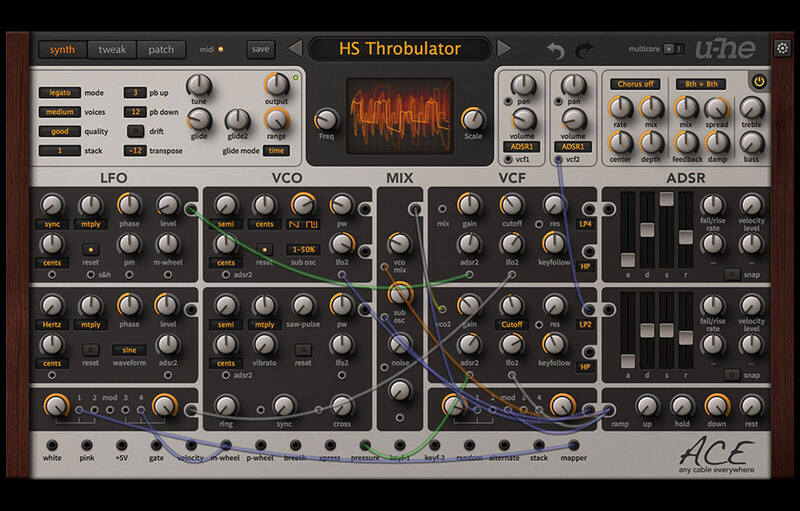 |
ACEAny Cable Everywhere ACE belongs to a new generation of synthesizers developed with the latest, fastest computers in mind. ACE offers classic modular synthesis and more at a fraction of the cost of dedicated hardware. But like its hardware forebears, you can patch any output into any input: the number of different ways to connect modules together is practically infinite. Needless to say, you will never run out of cables! The careful selection of modules and clear layout make ACE the ideal instrument for newcomers delving into the fascinating world of modular synthesis. But ACE also delivers the goods: like any medium-sized professional hardware system, ACE has enough synthesis power to keep you discovering new tricks for many years to come! List of Modules
Key Features At first glance ACE may seem overly simplistic, but remember that virtually anything can be plugged into anything else. For instance, try plugging an LFO into a Filter, then use that filter as an FM source for an oscillator. Crazy routing is possible, endless fun is guaranteed!
THIS IS A VIRTUAL PRODUCT Mac
Windows
Note: ACE is not a standalone product, it requires host software. Diva is compatible with nearly all DAWs.   Mapping Generator |
Price History: ACE 69.00 $ |
|
4.6 SOUND QUALITY FEATURES VALUE FOR MONEY EASE OF USE |
 |
Hive 2
Hive 2: Sleek, Streamlined, Supercharged
With its effortless workflow and low CPU usage, you can create stunning patches in next to no time at all. Hive is quick and uncomplicated, without sacrificing flexibility or audio quality. Now packed with more controls than ever, version 2 opens up new dimensions of expression… and sheer fun! Hive 2 in the Spotlight… MAIN FEATURES
Underneath its sleek exterior, Hive 2 lets you go as deep as you like. Add movement and life using the shape sequencer, or instantly record, rotate and arpeggiate note sequences. The 12-slot matrix even lets you modulate effect parameters, encouraging you to explore a whole new world of creative options. With its swappable audio engine, flexible signal routing, wavetable support and quality effects, Hive 2 makes sure you can get the sound you want with a minimum of fuss. Operating Systems:
Required Specifications:
Formats:
|
Price History: Hive 2 149.00 $ |
|
4.58 SOUND QUALITY FEATURES VALUE FOR MONEY EASE OF USE |
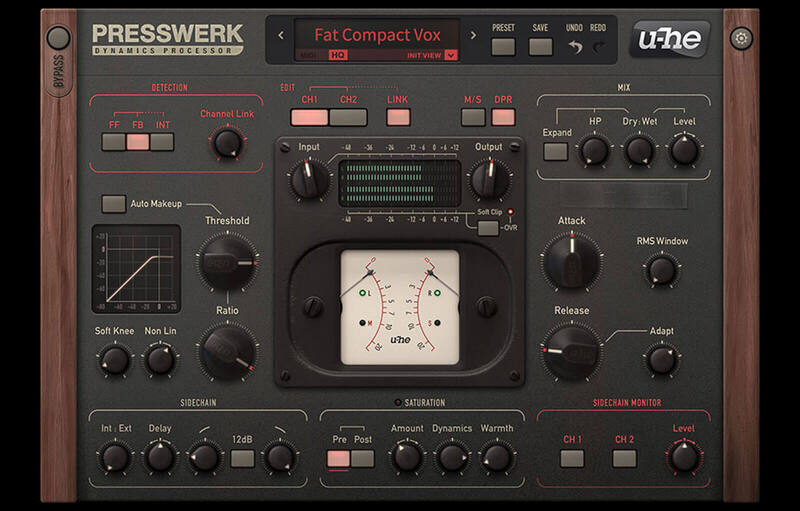 |
PresswerkPresswerk is designed to be a powerful dynamics processor rich with musical soul. An easy-to-use interface and a rich feature set give you hands on control to all the details of your sound. Presswerk is more than a copycat of other hardware compressors, it blends the warmth of classic hardware models with many modern touches. Presswerk has all the features you expect in a Compressor:
Plus, we have added some options to enhance Presswerk’s capabilities:
With Presswerk you can select from three different detection modes: FF (Feed-forward), FB (Feed-back) and INT (Interactive). Each one is a different style of Compression:
Compression has become an essential part of the studio – whether you are gently applying it to glue various parts together, or add some colouration and tone or adding loudness in the final mixdown of a track. Presswerk was created to fit into any workflow, no matter what task you throw at it – and do so with the style, attention to detail and sound quality you expect from u-he.
|
Price History: Presswerk 129.00 $ |
|
4.54 SOUND QUALITY FEATURES VALUE FOR MONEY EASE OF USE |
 |
UhbikUhbiquitous FX Bundle Uhbik is our fine collection of effect plug-ins for the discerning audiophile. Each surround-capable effect comes wrapped in a beautiful, streamlined interface. The entire bundle of nine effects is available now at an unbeatable price… Meet the Family… Four of these units (D, F, P, T) are modulation effects that include an ultra-slow to ultra-fast low frequency oscillator. LFO rate can be set to an absolute value (in seconds or Hertz), synced to host tempo (then scaled by a constant!) or swept manually / automated… Uhbik-A Ambience / Reverb, a very unusual combination of early reflections with different plate algorithms. While most of the other effects in the Uhbik family are geared towards the more synthetic, radical effects, Uhbik-A is the master of understatement. Great reverb is seldom conspicuous, but if itʼs not there, something is missing from the sound. With its independant control over high and low-frequency decays, diffusion and modulation, Uhbik-A delivers the kind of reverberations that can turn a flat sound into a warm space, or evoke the widest of landscapes! Uhbik-D Delay / echo with 5 ‘tape heads’, LFO or flutter modulation, low/high-cut filters, soft-clipping, per-tap feedback and multi-channel pan. Imagine an echo that repeats every quarter note, although precise quarters are not part of the echo signal? Or ping-pong delay (no central tap) that applies the Haas effect for extra movement? Or 7.1 surround delays… Uhbik can do all this and more – once again, the simplicity of the GUI belies its power. Uhbik-D is the perfect playground for creative delays without the overt complexity of MFM2 (see there!) Uhbik-F Flanger, from through-zero tape flanging (dramatic jet-effect!) to classic stomp-box type chorus, with LFO modulation and feedback / resonance Uhbik-F simulates two tape machines per audio channel, with recording and playback heads that can even occupy the same position if you want – impossible in the real world! Bass frequencies can bypass the effect (‘bass sanctuary’) to ensure LF-stability while the rest of the sound is swept around. Turn up the drive (2nd harmonic distortion), and your lead line will scorch its way through any mix! Uhbik-G Granular pitch-shifter / phase vocoder (via fast fourier analysis) delivers a wide range of dramatic contemporary effects. Whole grain goodness… Effectively cuts audio material into snippets (‘grains’), then plays them back at a variable rate – even backwards. In the original tape devices, the radius of a rotating cylindrical tape-head determined grain size and the length of tape in contact with the cylinder determined the overlap between grains. But Uhbik-G is not bound by the physical limitations of rotating cylinders – you can make it huge or impossibly small! Uhbik-P Phaser set to stun, with up to 42 allpass filters in series delivering the deepest, richest phasing available. But is it an angel or a metal monster? Again, bass frequencies can bypass the effect (‘bass sanctuary’) to ensure LF-stability. Again, resonance accentuates the comb filter effect, but unlike Uhbik-F the distance between peaks is kept fairly constant. As the signal is phase-shifted each time it is fed back, frequencies are created that were not present in the original signal – the main reason why Uhbik-P is also great for wild metallic effects! Uhbik-Q Equalizer, the perfect balance between simplicity and flexibility required a unique approach… Uhbik-Q is a revelation! Maximum flexibility from a minimum of controls, low CPU without compromising transparency. Uhbik-Q combines freely tunable frequency bands (4-pole filters, not the usual 2-pole!) with presets for other options. Q-factors automatically adjust to gain, an optional ‘mid’ bell curve filter adjusts to the two main bands… judging by the simple GUI, you would never guess just how much this EQ can do! Runciter Filter with parallel lowpass, bandpass and highpass outputs, resonance, controllable input overdrive and brick-wall fuzz. Filters were always dramatic sound-shaping tools, one reason why they’re still so popular. But users today expect more than a simple resonant lowpass, so here’s RUNCITER! For classic wah-wah, add low- and highpass together then control cutoff from a MIDI pedal. Or max out the resonance and drive the input from -48db to 48dB for a vast range of effects… instant glittering sweeps or absolute filter mayhem! Uhbik-S Frequency shifter / sideband filter with exceptional frequency response and low latency, can create anything from serene barber-pole waves to metallic FFF (full frequency freakout) effects! Movement in frequency shifters (no LFO required) is constantly downwards or upwards. In Uhbik-S, the barber-pole effect can even rise in one channel while falling in the other. Clever routines prevent otherwise inaudible sidebands from folding back into the audio range – Uhbik-S never compromises audio quality. Uhbik-T Tremolo – but if you think that just means ‘volume wobble’ you haven’t tried the mother of all tremolos yet: Uhbik-T! Our tremolo unit Uhbik-T is a general-purpose ‘rhythmicizer’ featuring linear or exponential (with 3 different strengths) gain modulation. But there’s much more: You can morph between user-defined patterns in the 11 x 16 grid, apply rhythmic lowpass filtering, add vibrato or Haas-delay spatial effects. In either of the pattern modes, the LFO wave knob selects a position between 11 user-defined patterns, and the LFO scale knob determines precisely how ‘choppy’ the effect is… tremolo redefined!
|
Price History: Uhbik 149.00 $ |
Are you looking for a brand that can help you take your sound design to the next level? Look no further than U-he! With their range of innovative software synthesizers and effects plugins, U-he offers a wide range of options for sound designers and music producers. Whether you’re looking for classic analog sounds or cutting-edge digital effects, U-he has something for you. So why wait? Buy U-he at the best price on Soundsmag today and start taking your sound design to new heights!




























